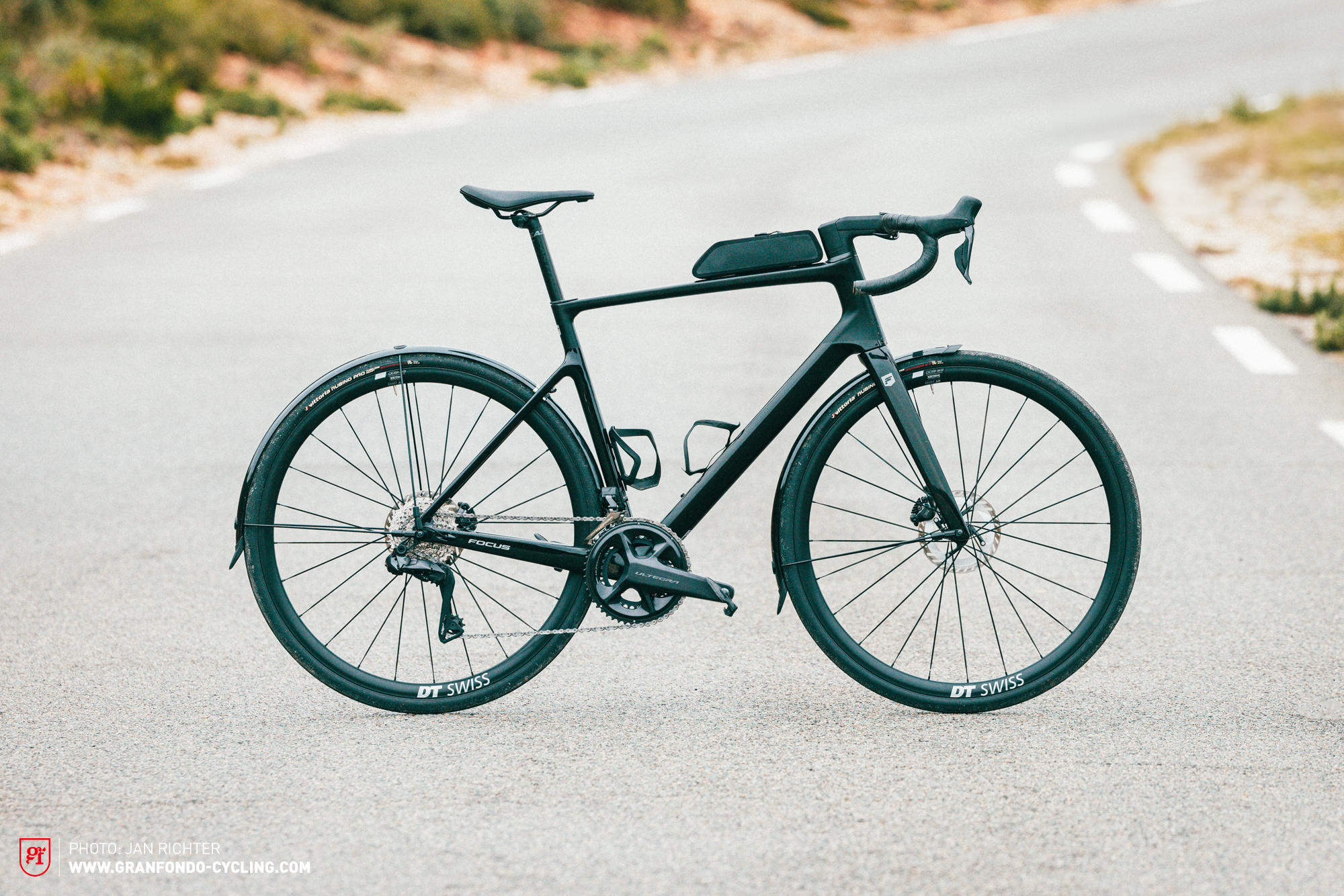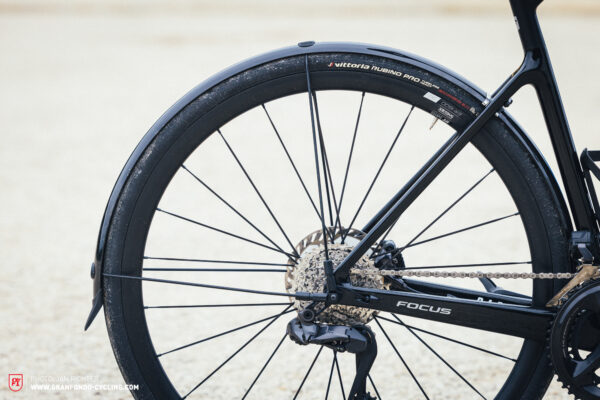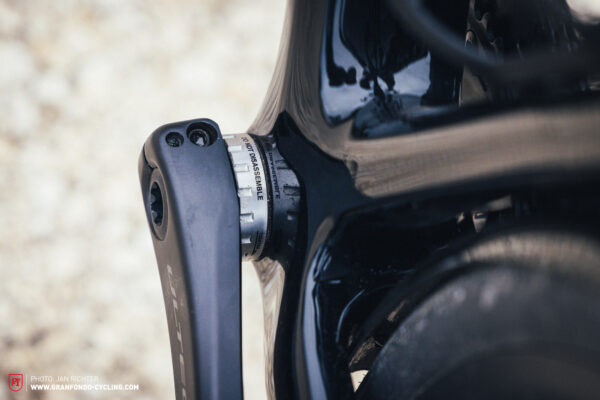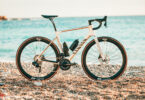The 2024 FOCUS PARALANE has all the essentials you need for the long haul, including a few modern extras, prioritising comfort and a subtle look. To this end, FOCUS have combined aerodynamic features with mudguards, ensuring both speed and everyday utility. Is it the ultimate all-roader?

This bike was tested as part of the 2024 all-road shootout – you can find an overview of the test field here: 2024 all-road shootout – The four hottest all-road bikes head to head.
Until recently, FOCUS’ drop-bar portfolio had a big gap between their race and gravel bikes. But then, in December, they introduced the 2024 FOCUS PARALANE. But wait a minute, we’ve seen the FOCUS PARALANE before, right? Correct. FOCUS first launched the PARALANE in 2017, and dropped it in 2022. The latest version introduces quite a few changes. In addition to an aggressive look that is strongly reminiscent of its high-performance sibling, the IZALCO MAX, they’ve resorted to NACA tube shapes for aero gains. At € 5,299, it’s the most affordable all-road bike of this shoot-out. However, it’s also the heaviest, tipping the scales at 8.6 kg.


What is the 2024 FOCUS PARALANE 8.9 made of?
The 2024 FOCUS PARALANE is consistently unobtrusive, minimalistic, timeless, and classy. It’s also got a relatively aggressive look. The mudguards water this down somewhat, while also shaping the bike’s appealing randonneur character. Somehow, it’s the opposite of a fancy look that you quickly grow tired of. The matt black parts of the frame aren’t random but rely on a special finish that’s intended to protect exposed areas. However, FOCUS include a set of protective film stickers, nonetheless. The top tube bag is included in the delivery, too, and it’s got a nicely matching shape. Thanks to three bosses on the down tube, there are two different positions for the bottle cage, which is very convenient when using a frame bag. Unfortunately, the stem is rather unattractive: it’s too chunky, and not as elegant as the rest of the bike. Fortunately, the bolts are all nicely hidden, unlike on the GIANT Defy. Changing the handlebar has been simplified thanks to semi-integrated cable routing. The branding is unobtrusive, which contributes to the bike’s timeless look.

The top tube bag is included, which is incredibly convenient, and it fits the bike seamlessly.

The matching PARALANE mudguards aren’t just very long, but also super-quick to install and remove.

The cables are semi-integrated neatly into the stem. This allows for easy adjustment of the handlebar with an otherwise clean look.
The FOCUS PARALANE 8.9 comes specced with a Shimano 2×12 ULTEGRA Di2 groupset, consisting of a 50/34 t crankset paired with an 11–34 t cassette. This suits the bike quite well, and the gear range should be sufficient in most cases. You might want a few easier gears after twelve hours in the saddle, and with all your gear strapped to the bike. It rolls on aluminium DT Swiss ER 1600 wheels. All other bikes in the test field feature carbon rims, but robust aluminium wheels definitely suit the PARALANE very well. Added to this is an equally sensible threaded BSA bottom bracket. When the time comes, you’ll easily source a new bottom bracket, and replacing it should be a breeze. The 27.2 mm diameter Easton EC70 seat post also relies on established standards, though, unfortunately, it doesn’t have a special flexing design like those on the other bikes in the test field. And the PARALANE could certainly do with a little more compliance. Regarding the Easton EC70 AX handlebar: some love it, others complain about its ergonomics. The tops aren’t flattened, and the round tubing can press uncomfortably on the palms of your hands under certain circumstances. That said, it’s very comfortable in the drops. Specialized and GIANT rely on high-end tires from their in-house brands, and Canyon spec the significantly more performance oriented Continental GP5000. The FOCUS PARALANE comes specced with Vittoria Rubino Pro TLR tires, which are heavier and more cumbersome in direct comparison. However, they deliver a high mileage and good puncture resistance with their 150 TPI nylon casings. The dedicated mudguards match the bike’s character to a tee, though they reduce the tire clearance from 35 to 33 mm. They’re available for an additional € 59.99. The components of the 2024 FOCUS PARALANE prioritise simplicity and durability, rather than performance and exclusivity, and they seem very sensibly chosen.

The threaded BSA bottom bracket is easy to replace, and replacements are easy to come by.

With its round, 27.2 mm seat post, the PARALANE also relies on an established standard here instead of fancy, flexy shapes.

Focus Paralane 8.9
€ 5,299
Specifications
Battery ´
Fork Paralane Carbon disc
Seatpost Easton EC70, carbon 27.2 mm
Brakes Shimano Ultegra R8170 160 mm
Drivetrain Shimano Ultegra Di2 R8150 12s 2 x 12
Chainring 50/34T
Stem FOCUS C.I.S. 2.0 100 mm
Handlebar Easton EC70 AX, carbon 420 mm
Wheelset DT Swiss ER 1600 12 x 100/12 x 142 mm Through Axle
Tires Vittoria Rubino Pro TLR 700 x 32c 32
Cranks Shimano Ultegra FC-R8100 50/34 172.5 mm
Cassette Shimano Ultegra 8100 11-34T
Technical Data
Size XS S M L XL
Specific Features
randonneur all-road bike
top tube bag included
matching mudguards available
components prioritise simplicity and durability
How does the 2024 FOCUS PARALANE 8.9 fare on the test track?
The 2024 FOCUS PARALANE will grow on you quickly. It doesn’t take long to acclimatise yourself to the handling or the riding position. The position feels balanced yet also quite aggressive. Compared to the more compact Canyon Endurace, the PARALANE feels rather stretched. You could say that it’s got true endurance geometry, like that of the steel randonneuring bikes of old. This is great when riding on asphalt, but it takes some getting used to on unpaved surfaces. The handling of the 2024 FOCUS PARALANE is balanced, and doesn’t come with any big surprises. It’s neither nervous nor demanding, just absolutely composed. However, it doesn’t motivate you to sprint for the finish or chase your local KOM. Instead, the bike encourages you to find your flow, and can just cruise along. It’s somewhat contradictory to the aggressive riding position and racy look.

Once the FOCUS PARALANE is up to speed, it just wants to keep going. While the bike does occasionally motivate you to get into the drops and sprint on the straights, it’s just for a little fun, not for the podium. Long, open corners are a blast, as the bike allows you to navigate them at high speed. However, it demands a lot of input on winding descents.
In terms of terrain, the PARALANE clearly feels at home on asphalt. Its compliance isn’t outstanding, but it’s perfectly sufficient for most road conditions. However, it’s only suitable for off-road detours and excursions into the unknown to a limited extent. You can clearly feel the vibrations on gravel roads, especially compared to the other all-road bikes on test, which all rely on special damping elements.
This bike favours long-distance flow and has a real randonneur feel.

Who is the 2024 FOCUS PARALANE 8.9 for?
Anyone looking for a reliable companion rather than a quick adventure is well-advised to go with the 2024 FOCUS PARALANE. If, on the other hand, you’re looking for more of the racing type, this all-road bike is not for you. In that case, the GIANT is the better choice. However, if riding pleasure and flow are more important to you than breaking records, and if you ride for the feeling, it’s perfectly suited to you. In any case, the PARALANE is guaranteed to be fun as a fast commuter, and on long asphalt rides. To be honest, it’s a bike that probably suits more people than they’d like to admit.

Tuning tip: Tan-wall tires for a randonneur look.
Our conclusion on the FOCUS PARALANE 8.9
The FOCUS PARALANE 8.9 is a perfect companion for those relaxed, pleasant, and long days in the saddle. It will ride with you through thick and thin. It’s a superbly balanced and intuitive endurance all-road bike that feels most comfortable on asphalt. That said, it can handle short detours on forest service roads. The components prioritise simplicity and durability. It’s not a fancy superbike that stands out from the crowd, but a down-to-earth road bike for the long haul.
Tops
- original endurance character
- timeless look
- matching mudguards
Flops
- tires feel somewhat sluggish and cumbersome
For more information, visit focus-bikes.com

Did you enjoy this article? If so, we would be stoked if you decide to support us with a monthly contribution. By becoming a supporter of GRAN FONDO, you will help secure a sustainable future for high-quality cycling journalism. Click here to learn more.
Words: Martin Staffa Photos: Jan Richter







